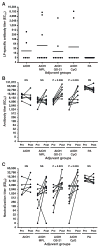Epitope-focused peptide immunogens in human use adjuvants protect rabbits from experimental inhalation anthrax
- PMID: 25454087
- PMCID: PMC4391504
- DOI: 10.1016/j.vaccine.2014.11.042
Epitope-focused peptide immunogens in human use adjuvants protect rabbits from experimental inhalation anthrax
Abstract
Background: Anthrax represents a formidable bioterrorism threat for which new, optimized vaccines are required. We previously demonstrated that epitope-focused multiple antigenic peptides or a recombinant protein in Freund's adjuvant can elicit Ab against the loop neutralizing determinant (LND), a cryptic linear neutralizing epitope in the 2ß2-2ß3 loop of protective antigen from Bacillus anthracis, which mediated protection of rabbits from inhalation challenge with B. anthracis Ames strain. However, demonstration of efficacy using human-use adjuvants is required before proceeding with further development of an LND vaccine for testing in non-human primates and humans.
Methods: To optimize the LND immunogen, we first evaluated the protective efficacy and immune correlates associated with immunization of rabbits with mixtures containing two molecular variants of multiple antigenic peptides in Freunds adjuvant, termed BT-LND(2) and TB-LND(2). TB-LND(2) was then further evaluated for protective efficacy in rabbits employing human-use adjuvants.
Results: Immunization of rabbits with TB-LND(2) in human-use adjuvants elicited protection from Ames strain spore challenge which was statistically indistinguishable from that elicited through immunization with protective antigen. All TB-LND(2) rabbits with any detectable serum neutralization prior to challenge were protected from aerosolized spore exposure. Remarkably, rabbits immunized with TB-LND(2) in Alhydrogel/CpG had significant anamnestic increases in post-challenge LND-specific Ab and neutralization titers despite little evidence of spore germination in these rabbits.
Conclusions: An LND-specific epitope-focused vaccine may complement PA-based vaccines and may represent a complementary stand-alone vaccine for anthrax.
Keywords: Antibody; Epitope; Inhalation anthrax; Neutralization; Peptide; Vaccine.
Copyright © 2014 Elsevier Ltd. All rights reserved.
Conflict of interest statement
Figures





References
-
- Galloway D, Liner A, Legutki J, Mateczun A, Barnewall R, Estep J. Genetic immunization against anthrax. Vaccine. 2004;22:1604–8. - PubMed
-
- Migone TS, Subramanian GM, Zhong J, Healey LM, Corey A, Devalaraja M, et al. Raxibacumab for the treatment of inhalational anthrax. N Engl J Med. 2009;361:135–44. - PubMed
-
- Gorantala J, Grover S, Rahi A, Chaudhary P, Rajwanshi R, Sarin NB, et al. Generation of protective immune response against anthrax by oral immunization with protective antigen plant-based vaccine. J Biotechnol. 2014;176:1–10. - PubMed
Publication types
MeSH terms
Substances
Supplementary concepts
Grants and funding
LinkOut - more resources
Full Text Sources
Other Literature Sources
Medical
Molecular Biology Databases

